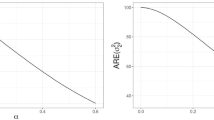Abstract
This article develops a new and stable estimator for information matrix when the EM algorithm is used in maximum likelihood estimation. This estimator is constructed using the smoothed individual complete-data scores that are readily available from running the EM algorithm. The method works for dependent data sets and when the expectation step is an irregular function of the conditioning parameters. In comparison to the approach of Louis (J. R. Stat. Soc., Ser. B 44:226–233, 1982), this new estimator is more stable and easier to implement. Both real and simulated data are used to demonstrate the use of this new estimator.
Similar content being viewed by others
References
Cappe, O., Moulines, E.: On the use of particle filtering for maximum likelihood parameter estimation. In: European Signal Processing Conference (EUSIPCO), Antalya, Turkey (2005)
Dempster, A.P., Laird, N.M., Rubin, D.B.: Maximum likelihood from incomplete data via the EM algorithm. J. Am. Stat. Assoc., Ser. B 39, 1–38 (1977)
Doucet, A., de Freitas, N., Gordon, N. (eds.): Sequential Monte Carlo Methods in Practice. Springer, Berlin (2001)
Jamshidian, M., Jennrich, R.I.: Standard errors for EM estimation. J. R. Stat. Soc., Ser. B 62, 257–270 (2000)
Kiefer, N.M., Vogelsang, T.J.: A new asymptotic theory for heteroskedasticity-autocorrelation robust tests. Econom. Theory 21, 1130–1164 (2005)
Louis, T.A.: Finding the observed information matrix when using the EM algorithm. J. R. Stat. Soc., Ser. B 44, 226–233 (1982)
Meilijson, I.: A fast improvement to the EM algorithm on its own terms. J. R. Stat. Soc., Ser. B 51, 127–138 (1989)
Meng, X.L., Rubin, D.B.: Using EM to obtain asymptotic variance-covariance matrices: the SEM algorithm. J. Am. Stat. Assoc. 86, 899–909 (1991)
Newey, W.K., West, K.D.: A simple, positive semi-definite, heteroskedasticity and autocorrelation consistent covariance matrix. Econometrica 55, 703–708 (1987)
Olsson, J., Cappe, R., Douc, R., Moulines, E.: Sequential Monte Carlo smoothing with application to parameter estimation in non-linear state space models. Bernoulli 14, 155–179 (2008)
Shumway, R.H., Stoffer, D.S.: An approach to time series smoothing and forecasting using the EM algorithm. J. Time Ser. Anal. 3, 253–264 (1982)
Author information
Authors and Affiliations
Corresponding author
Additional information
A. Fulop is a research fellow at CREST.
Rights and permissions
About this article
Cite this article
Duan, JC., Fulop, A. A stable estimator of the information matrix under EM for dependent data. Stat Comput 21, 83–91 (2011). https://doi.org/10.1007/s11222-009-9149-4
Received:
Accepted:
Published:
Issue Date:
DOI: https://doi.org/10.1007/s11222-009-9149-4




